Dictation 必修五 Unit 5 First aid 姓名
人教版高中英语必修五教案:Unit 5 first Aid
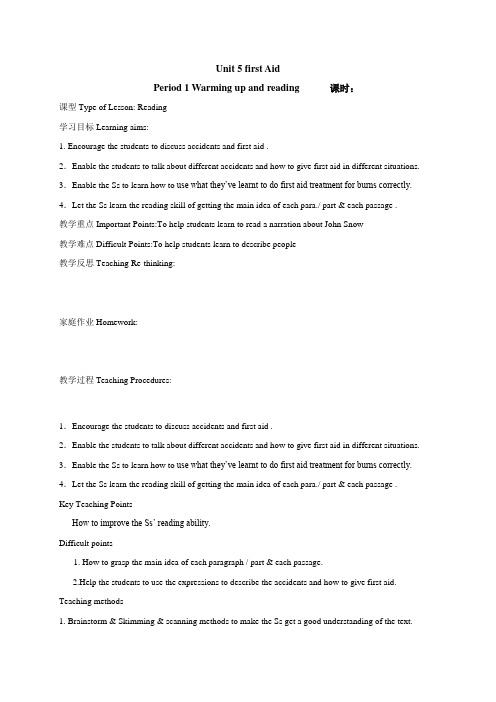
Unit 5 first AidPeriod 1 Warming up and reading 课时:课型Type of Lesson: Reading学习目标Learning aims:1. Encourage the students to discuss accidents and first aid .2.Enable the students to talk about different accidents and how to give first aid in different situations. 3.Enable the Ss to learn how to use what they’ve learnt to do first aid treatment for burns correctly. 4.Let the Ss learn the reading skill of getting the main idea of each para./ part & each passage .教学重点Important Points:To help students learn to read a narration about John Snow教学难点Difficult Points:To help students learn to describe people教学反思Teaching Re-thinking:家庭作业Homework:教学过程Teaching Procedures:1.Encourage the students to discuss accidents and first aid .2.Enable the students to talk about different accidents and how to give first aid in different situations. 3.Enable the Ss to learn how to use what they’ve learnt to do first aid treatment for burns correctly. 4.Let the Ss learn the reading skill of getting the main idea of each para./ part & each passage .Key Teaching PointsHow to improve the Ss’ reading ability.Difficult points1. How to grasp the main idea of each paragraph / part & each passage.2.Help the students to use the expressions to describe the accidents and how to give first aid. Teaching methods1. Brainstorm & Skimming & scanning methods to make the Ss get a good understanding of the text.2.Discussion methods to make the Ss understand what they’ve learned in class.3.Pair work of group to get every student to take part in the teaching-and-learning activities.Teaching proceduresTeaching aidsA recorder, a projector, and a computerStep One Warming up1.Lead-in question: Watch a video, and fill in the blanks: what is first aid?First aid is a temporary form of help given to someone who suddenly falls ill or gets injured before a doctor can be found. Often the illness or injury is not serious, but there are other times when giving first aid quickly will save one’s life.2. Warming-up: Brainstorming: What words can you think of when you talk about accidents and first aid? Quiz for first aid (on p74)1. The best way to treat a hurt ankle is to:A.Put an ice pack on your ankle.B.Put a heating pad(垫子)around your ankle.C.Keep on walking and jumping.2. If you get a nosebleed, gently let your head back to stop the bleeding.A. TrueB. False3. To treat a burn, you:A. Rub(擦)some butter on it.B. Hold the burnt part under cold running water.C. Put salt on the burnt part.4. You should wait at least five minutes before touching somebody who has been struck by lightening, or you might get a shock (打击). A. True B. False5.Your friend has an asthma(哮喘) attack, but she doesn’t have her medicine. You’d better:A. Get a paper bag for her to breathe into.B. Get her a cup of coffee.C. Take her outside for fresh air.6. To treat a choke, you should make him /her spit by patting him/her on the back.A. TrueB. False7. If someone is having a heart attack, you should first:A. Call 120B. Perform CPR (心肺复苏)8.Which person would you help first?___A Li Yan who has cut her foot on glassB Xue Jin whose nose is bleedingC GaoYuan who is on the ground not breathingD Wang Feng who has broken her arm.9.When carrying ou t rescue breathing, how many times a minute should you blow air into the victim’s mouth? ______. A 4 B 8 C 15 D 2010. How would you stop severe bleeding? ___A cover the wound with plasticB wash the woundC do nothing as the bleeding will stop by itselfD put a bandage over the wound and then press on it5 A friend is choking on a piece of food and is coughing badly. What should you do?___A nothingB carry out rescue breathingC have her lie down and restD slap her four or five times on her back4.Talk about different situations and the way they should give first aid.Qs: Turn to page 33, look at the pictures.What happened in each picture? What kind of first aid should you give?A snake bite: A snake has bitten him on his leg.(The person bitten must get to a doctor or hospital at once; /Speed is very important. /It will help the doctor greatly if you can tell him what kind of snake it was, or describe the situation .)Bleeding: She has cut her arm with some broken glass and is bleeding badly.(Try to stop the bleeding;/Press a handkerchief onto the bleeding point and hold it there;/Hold up the part of body which is bleeding if possible.)*(watch the video about how to deal with bleeding )A sprained ankle: He has badly sprained his ankle.(Tied with medical bandage. /It is better to avoid walking with the injured ankle. /It is correct to use ice bag for removing pain and bleeding, and also not influence our own body healing.)*( a video about a sprained ankle)Choking : She is choking on a piece of food (Make him /her spit by patting him/her on the back./ Don’t eat too fast and don’t forget to chew your food./To avoid this, we shouldn’t talk or laugh when eating.)*(a video about unconscious choking)A broken arm : She has broken her arm. (Do not move the patient. /Send for an ambulance at once. /Treat for shock if necessary.A bleeding nose: He has a nose/a nose bleed.(Stay calm. / Breathe through the mouth, not the nose. / Sit up and bend the head slightly forward. / Pinch 捏both nostrils鼻孔shut using a thumb and forefinger./ Spit out any blood that collects in the mouth. Step Two Pre-reading:1. Questions for the picture on P33:What has happened? What sort of injuries the child will have?What kind of first aid would you perform in the situation of burning?Key: Cool the area of skin; Wash it under the cold running water.Cover the wound with bandage/clean cloth. See a doctor if necessary.Unit 5 first AidPeriod 1 Warming up and reading 课时:课型Type of Lesson: Reading学习目标Learning aims:1. Encourage the students to discuss accidents and first aid .2.Enable the students to talk about different accidents and how to give first aid in different situations. 3.Enable the Ss to learn how to use what they’ve learnt to do first aid treatment for burns correctly. 4.Let the Ss learn the reading skill of getting the main idea of each para./ part & each passage .教学重点Important Points:To help students learn to read a narration about John Snow教学难点Difficult Points:To help students learn to describe people教学反思Teaching Re-thinking:家庭作业Homework:Step Three Fast readingLet the Ss read the passage fast and then find out the answers to the questions1. What will the passage be about?2. What do they tell you about the passage?3. In which order are these topics covered in the text? Number them from 1 to 5.In which order are these topics covered in the text? Number them from 1 to 5.(P35Ex1)(3) the three types of burns(5) what to do if someone gets burned(1 ) the functions of the skin(4) the symptoms of burns(2) how we get burnsStep Four Detailed reading Fill in the blanks1.What can skin do for our body ?.Protect you against diseases, poisons and the sun’s harmful ray s..Keep you warm or cool..Prevent you from losing water..Give you sense of touch.2.Causes of burnsYou can get burnt by : hot liquids; steam; fire radiation; the sun electricity and chemicals3.Types of burnWhat are they?1.First degree burns.2. Second degree burns3.Third degree burns4. Label these pictures first, second and third degree burns.(P35 Ex2)5.Fill in the blanks Types & characteristics of burns (based on page 34) 1. Types 2. CharacteristicsFirst degree burns Affect the top______ of the skin. Dry, red and mildly ______. _______ painful. Turn white when ______.Second degree burns Affect both the ____ & the ______ layer.________, red and swollen. Extremely painful. ________ waterysurface Third degree burns Affect_____ ________ layers of the skin. Swollen;______ canbe seen.______ or ____ pain if the nerves are damaged.Black and white and _______. 6..Answer the questions(Page35 Ex3)1).Why should you put cold water on a burn? Because the cold water stops the burning process, stops the pain and reduces the swelling.2). Why doesn’t a third degree burn hurt?Because in the third degree burn the nerves have been damaged. If there are no nerves, there is no pain.3). Why do you think clothes and jewellery near burns should be removed?Because bacteria from the clothes and jewellery could infect the burns.4). If someone has a third degree burn, why might you see tissue?Because all the layers of the skin have been burnt showing the tissue underneath. 7.Decide whether the first aid treatment is Right (R) or Wrong (W). (35 Ex4)Unit 5 first AidPeriod 2&3 Language focus 课时:课型Type of Lesson: Words & Expressions学习目标Learning aims: To help students learn to use some important words and expressions教学重点Important Points:To help students learn to remember some important words and expressions 教学难点Difficult Points:To help students learn to use some important words and expressions教学反思Teaching Re-thinking:家庭作业Homework:Language pointsWarming-up1. aid [U] &[C] help; something that gives help帮助,援助;助手,辅助设备;救护first aid 急救come/ go to sb’s aid 援助某人cut off aids 终止援助with the aid of 在… 的帮助下/借助于in aid of sth/sb 为了帮助a hearing aid助听器teaching aids教具medical aid医疗救护vt. give help to 1.帮助,援助2.急救aid sb with sth 帮助某人做某事aid sb in doing sth 帮助某人做某事Eg. He came to my aid at once.He was able to find the museum with the aid of a map.We aided him in raising the money.He raised money in aid of the sick.2. temporary 暂时的,临时的temporary relief from pain短暂的解痛temporary work/ solution临时工作/解决办法3. fall ill 生病属短暂性动词, 不与for + 时间段连用be ill 指生病的状态,是持续性行为, 可与for + 时间段连用His wife suddenly fell ill last week. He has been ill for a week.fall 用作系动词,后常接形容词.fall asleep 睡着fall silent 沉默不语4. injure v. injury n. injured adj.*get injured 受伤get+及物动词的过去分词构成被动语态Get lost/get paid/ get damaged/ get married/ get broken/ get repaired /get burned/get infected*injury n. 受伤处; 损害; 伤害injury to s th. …(部位)的伤He suffered serious injuries to the arms and legs.他的双臂和双腿严重受伤。
(带答案)人教版高中英语必修五第5讲:Unit5 First aid

Unit5 First aid一、词语翻译:1. 急救 ________________________2. 生病 ________________________3. 榨出; 挤出 __________________4. 反复; 多次___________________5. 在适当的位置; 适当 __________6. 有影响 ___________________7. 找到 ________________________ 8. 触觉 ____________________9. 申请(某物) __________________ 10. 赠某物给某人_________________二、词形变化:1. treat v. _____________________ (n.治疗;对待)2. bear v. _____________________ (adj.难以忍受的)3. injure v. ____________________ (n.伤) ______________ (adj.受伤的)4. brave adj. ___________________ (n.勇敢,勇气)5. poison n.v. ___________________ (adj.有毒的)6. vary v. ________________ (n.种类,变化) _______________ (adj.多种多样的)7. press v. ________________ (n.压力)8. organ n. _________________ (adj.有机的)9. apply v. _______________ (n.申请,应用) _______________ (n.申请人)10. blood n. _______________ (v.流血) _______________ (adj.流血的)1.掌握重点词汇的搭配及用法,能够正确完成基础类型题。
新人教版必修五unit 5《first aid》优秀教案(重点资料).doc

Lesson Plan InterpretationUnit5 First Aid for Burns(Reading)刘寒青0805020165Analysis of the teaching materialThe new course is about the Reading Part of Unit 5 First Aid for Burns in NEW SENIOR ENGLISH FOR CHINA STUDENTS’BOOK 5. It focuses on the Ss’abilities to gather information; deal with information; solve problems and the abilities to think and express in English. It is very important for the Ss to learn because it helps Ss a lot in getting the abilities mentioned above. It first introduces the importance of the skin to our body, then introduces types of burns, characteristics of burns and certain steps of first aid treatments. It is hoped that through the passage, the Ss will know how to perform first aid procedures for burns and do first aid calmly during an emergency.About the SsAs Senior2 Ss, they have basic reading and speaking abilities, but they are at different levels of English fluency. So during the lesson, I arrange a variety of activities from easy to difficult to let all of them join in to attract their interest and let them be confident and taste the joy of success.Teaching goals1. Knowledge goalsTo enable the Ss to master the important words and sentences patterns of this unit through this period: injury, bleed, organ, poison, swell, damage, wound, mild, squeeze out, symptom, etc.2. Ability goals1). Help the Ss to analyze the structure and layout of the text2). Let the Ss learn the reading skill of getting the main idea of each part and pay attention tosome crucial details3).Enable the Ss to have the ability to use what they’ve learnt to do first aid treatment for burnscorrectly and make a first-aid-kit.3.Moral goalsIncrease the Ss’awareness of the importance of knowing about first aid.Key teaching points and difficult points1. How to help the Ss have the ability to use what they’ve learnt to do first aid treatment forburns correctly.2. How to improve the Ss’reading ability.3. How to grasp the main idea of each paragraph and the passage.Teaching methodsTask-based method, skimming, scanning, competition, discussion,role-play, class work, etc.Teaching aids:Multi-media, a first-aid-kit, the contents of a first-aid-kitTeaching proceduresStep1. Lead-inI’ll show the Ss a video about first aid for burns. The video is in English, so the Ss maybe cannot totally understand it. That exactly causes the Ss’interest on first aid for burns. Then introduce the new words and phrases.Step2. Pre-readingThe pre-reading prepares Ss for the passage and relates the subjects of their own experience. They are encouraged to speak out their answer. Different answers are available.Step3. Fast readingThis task is to check the Ss’skimming ability. The purpose is to let the Ss get the main idea of the passage and what the text is about.Step4. Detailed readingAsk the Ss to finish some questions by using competitions. I’ll divide the Ss into 4 groups. If a student can answer the question correctly, then his/ her group can get one point. And the group which gets the most points is the winner. Only through co-operation can the Ss taste the joy of success. If the Ss know their answer is right, he’ll be confident and they’ll surely become more enthusiasm in learning English. These questions are designed from the easiest one to the most difficult one for different levels’Ss. The purpose is to the Ss’reading comprehension.Step5. Words competitionThis is a task-based activity by continuing the competition to check the Ss’words spelling. The task is so easy that all of the Ss will show interested in it. So they can learn the words easily.Step6. Role playThis is an interesting task-based activity. The task is to develop the Ss’abilities to speak and express in English and their reaction. The purpose is to train the Ss to prepare for an emergency before it happens.Step7. SummaryFrom the passage, the Ss will have a clear idea about First Aid for Burns and they can do first aid treatment for burns correctly. They also learn to how to make an emergency call for help. Through the passage, the Ss’thinking ability and acting ability are improved.Step8. HomeworkAsk the Ss to read the book called First Aid for the Family.Then write an introduction to it and introduce it to the classnext period.Feed backThis lesson is a reading course, which is mainly about first aid for burns. It focuses on the Ss’abilities to gather information; deal with information; solve problems and the abilities to think and express in English. Through the lesson, I hope that the Ss will know how to perform first aid procedures for burns and do first aid calmly during an emergency when they face burns in reality.。
高中英语必修5(人教新课标)Unit 5 First aid 知识点总结
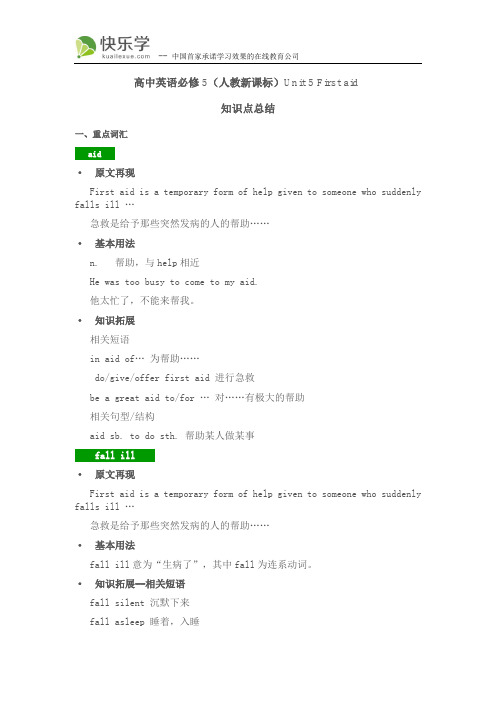
高中英语必修5(人教新课标)Unit 5 First aid知识点总结一、重点词汇aid·原文再现First aid is a temporary form of help given to someone who suddenly falls ill …急救是给予那些突然发病的人的帮助……·基本用法n. 帮助,与help相近He was too busy to come to my aid.他太忙了,不能来帮我。
·知识拓展相关短语in aid of… 为帮助……do/give/offer first aid 进行急救be a great aid to/for … 对……有极大的帮助相关句型/结构aid sb. to do sth. 帮助某人做某事fall ill·原文再现First aid is a temporary form of help given to someone who suddenly falls ill …急救是给予那些突然发病的人的帮助……·基本用法fall ill意为“生病了”,其中fall为连系动词。
·知识拓展--相关短语fall silent 沉默下来fall asleep 睡着,入睡fall down/over 跌倒,绊倒fall off 脱落,脱离injury·原文再现Often the illness or injury is not serious,…通常这种疾病或伤势并不严重……·基本用法n. 损伤;伤口,伤害(名词复数: injuries)·知识拓展其他词性injury v. 受伤,伤害词义辨析hurt/injure/wound/cutvariety·原文再现You can get burned by a variety of things:…你可能会因为各种原因被烫伤:……·基本用法n. 不同种类,多种式样;变化;多样化;多变性(名词复数:varieties)We all need variety in our diet.我们都需要饮食多样化。
必修五 Unit 5 First aid Word版含答案
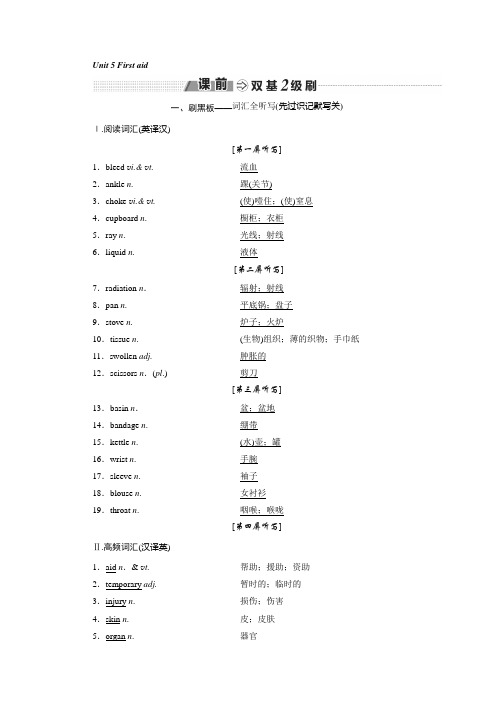
Unit 5 First aid一、刷黑板——词汇全听写(先过识记默写关)Ⅰ.阅读词汇(英译汉)[第一屏听写]1.bleed v i.& v t.流血2.ankle n. 踝(关节)3.choke v i.& v t.(使)噎住;(使)窒息4.cupboard n. 橱柜;衣柜5.ray n. 光线;射线6.liquid n. 液体[第二屏听写]7.radiation n.辐射;射线8.pan n. 平底锅;盘子9.stove n. 炉子;火炉10.tissue n. (生物)组织;薄的织物;手巾纸11.swollen adj.肿胀的12.scissors n.(pl.) 剪刀[第三屏听写]13.basin n.盆;盆地14.bandage n. 绷带15.kettle n. (水)壶;罐16.wrist n. 手腕17.sleeve n. 袖子18.blouse n. 女衬衫19.throat n. 咽喉;喉咙[第四屏听写]Ⅱ.高频词汇(汉译英)1.aid n.& v t.帮助;援助;资助2.temporary adj.暂时的;临时的3.injury n. 损伤;伤害4.skin n. 皮;皮肤5.organ n. 器官6.barrier n. 屏障;障碍(物)[第五屏听写]7.poison n.毒药;毒害v t.毒害;使中毒8.complex adj.复杂的9.variety n. 变化;多样(化);多变(性) 10.mild adj.轻微的;温和的;温柔的11.mildly ad v. 轻微地;温和地[第六屏听写] 12.unbearable adj.难以忍受的;不能容忍的13.squeeze v t.& v i.榨;挤;压榨14.vital adj.至关重要的;生死攸关的15.symptom n. 症状;征兆16.pour v t.& v i.倒;灌;注;涌17.damp adj.潮湿的18.tight adj.牢的;紧的;紧密的[第七屏听写]19.tightly ad v.紧地;牢牢地20.firm adj.(动作)稳定有力的;坚定的21.firmly ad v. 坚固地;稳定地22.ceremony n. 典礼;仪式;礼节23.bravery n. 勇敢;勇气24.treat v t.& v i.治疗;对待;款待n. 款待;招待[第八屏听写]25.apply v t.涂;敷;搽;应用;运用v i.申请;请求;使用;有效26.pressure n. 压力;挤压;压迫(感) 27.ambulance n. 救护车28.swell v i.& v t.(使)膨胀;隆起29.first_aid (对伤患者的)急救30.fall_ill 生病[第九屏听写]31.electric_shock触电;电休克32.squeeze_out 榨出;挤出33.over_and_over_again 反复;多次34.in_place 在适当的位置;适当35.a_number_of 若干;许多36.put_one's_hands_on 找到37.make_a_difference 区别对待;有影响;起(重要)作用二、刷清单——热身自盘点(再过基本应用关) (一)核心单词一、过重点单词——纵引横联超人一点1.aid n .& vt.帮助;援助;资助[教材原句] First aid is a temporary form of help given to someone who suddenly falls ill or gets injured before a doctor can be found.急救就是在找到医生之前对突然生病或受伤的人给予临时性的帮助。
人教新课标版高中英语必修五Unit5Firstaid知识讲解
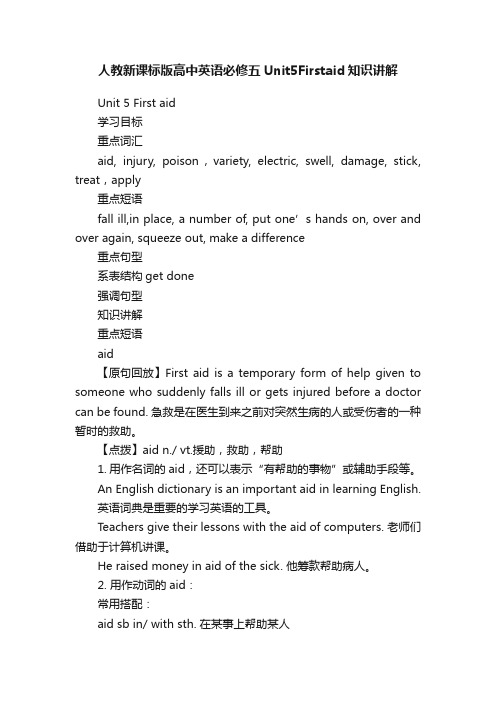
人教新课标版高中英语必修五Unit5Firstaid知识讲解Unit 5 First aid学习目标重点词汇aid, injury, poison,variety, electric, swell, damage, stick, treat,apply重点短语fall ill,in place, a number of, put one’s hands on, over and over again, squeeze out, make a difference重点句型系表结构get done强调句型知识讲解重点短语aid【原句回放】First aid is a temporary form of help given to someone who suddenly falls ill or gets injured before a doctor can be found. 急救是在医生到来之前对突然生病的人或受伤者的一种暂时的救助。
【点拨】aid n./ vt.援助,救助,帮助1. 用作名词的aid,还可以表示“有帮助的事物”或辅助手段等。
An English dictionary is an important aid in learning English.英语词典是重要的学习英语的工具。
Teachers give their lessons with the aid of computers. 老师们借助于计算机讲课。
He raised money in aid of the sick. 他筹款帮助病人。
2. 用作动词的aid:常用搭配:aid sb in/ with sth. 在某事上帮助某人aid sb. to do sth. 帮助某人做某事I aided the people who suffered from the big earthquake with money.我用钱来援助在地震中受灾的人们。
人教新课标版高中英语必修五 Unit 5 First aid 知识讲解-教育文档

Unit 5 First aid学习目标重点词汇aid, injury, poison,variety, electric, swell, damage, stick, treat,apply重点短语fall ill,in place, a number of, put one’s hands on, over and over again, squeeze out, make a difference重点句型系表结构get done强调句型知识讲解重点短语aid【原句回放】First aid is a temporary form of help given to someone who suddenly falls ill or gets injured before a doctor can be found. 急救是在医生到来之前对突然生病的人或受伤者的一种暂时的救助。
【点拨】aid n./ vt.援助,救助,帮助1. 用作名词的aid,还可以表示“有帮助的事物”或辅助手段等。
An English dictionary is an important aid in learning English.英语词典是重要的学习英语的工具。
Teachers give their lessons with the aid of computers. 老师们借助于计算机讲课。
He raised money in aid of the sick. 他筹款帮助病人。
2. 用作动词的aid:常用搭配:aid sb in/ with sth. 在某事上帮助某人aid sb. to do sth. 帮助某人做某事I aided the people who suffered from the big earthquake with money.我用钱来援助在地震中受灾的人们。
Vitamin C aids in the absorption of iron. 维生素C有助于铁的吸收。
人教新课标高中英语必修五Unit5FirstaidUnit5Firstaid教案.docx
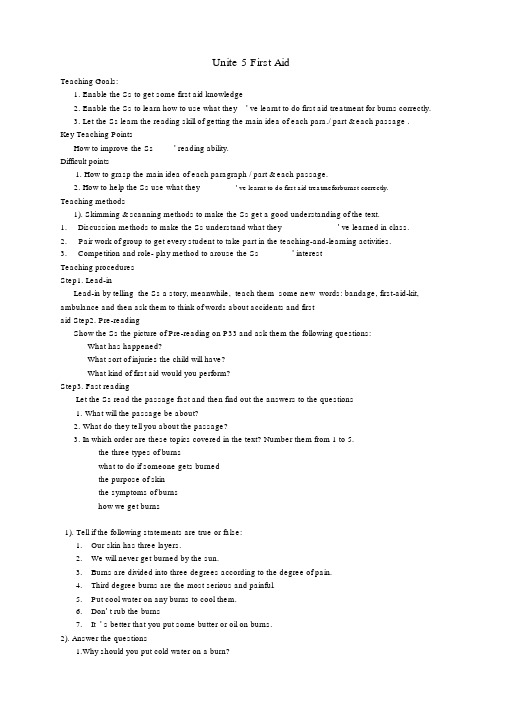
Unite 5First AidTeaching Goals:1.Enable the Ss to get some first aid knowledge2.Enable the Ss to learn how to use what they ’ ve learnt to do first aid treatment for burns correctly.3.Let the Ss learn the reading skill of getting the main idea of each para./ part & each passage .Key Teaching PointsHow to improve the Ss’ reading ability.Difficult points1. How to grasp the main idea of each paragraph / part & each passage.2. How to help the Ss use what they’ ve learnt to do first aid treatmeforburnst correctly.Teaching methods1). Skimming & scanning methods to make the Ss get a good understanding of the text.1. Discussion methods to make the Ss understand what they’ ve learned in class.2.Pair work of group to get every student to take part in the teaching-and-learning activities.3. Competition and role- play method to arouse the Ss’ interestTeaching proceduresStep1. Lead-inLead-in by telling the Ss a story, meanwhile, teach them some new words: bandage, first-aid-kit, ambulance and then ask them to think of words about accidents and firstaid Step2. Pre-readingShow the Ss the picture of Pre-reading on P33 and ask them the following questions: What has happened?What sort of injuries the child will have?What kind of first aid would you perform?Step3. Fast readingLet the Ss read the passage fast and then find out the answers to the questions1.What will the passage be about?2.What do they tell you about the passage?3.In which order are these topics covered in the text? Number them from 1 to 5.____ the three types of burns____ what to do if someone gets burned____ the purpose of skin____ the symptoms of burns____ how we get burns1). Tell if the following statements are true or false:1.Our skin has three layers.2.We will never get burned by the sun.3.Burns are divided into three degrees according to the degree of pain.4.Third degree burns are the most serious and painful.5.Put cool water on any burns to cool them.6.Don’ t rub the burns7.It ’ s better that you put some butter or oil on burns.2). Answer the questions1.Why should you put cold water on a burn?2.Why doesn’ t a third degree burn hurt?3.Why do you think clothes and jewellery near burns should be removed?4.If someone has a third degree burn, why might you see tissue?3). Read the text again and then find out how many parts there are and the main idea of each part:Part1. The purpose / function of skinPart2. Causes of burns hot liquids, steam, fire, radiation, the sun, electricity, chemicalsPart3. Types of burns: First degree burns, Second degree burns, Third degree burnsPart4. Characteristics of burnsPart5 First aid treatment3). Finish off Comprehending Ex2&3Step5. Words competitionHave a competition to check the Ss ’ words spelling Step6.Making a first-aid kitAn activity to let the Ss know what are included in a first-aid-kitA well-stocked( 存得好的 ) first-aid kit, kept in easy reach, is necessary in every home. It should include: bandage, alcohol, flashlight, thermometer, soap, sharp scissors, plastic gloves (at least 2 pairs), your list of emergency phone numbers etc.Step7. Role playWork in pairs to act out how to place an emergency call for helpStep8. SummaryThis passage doesn ’ t contain enough information for you to do first aid f o thers. Please learn more after class. Do remember: Life is precious, we should care about others and help people in an emergency and try our best to give them effective first aid if they are in danger. Period 2. Language points.1.aid帮助,援助,助first aid急救come/ go to sb ’said援助某人with the aid of在⋯ 的帮助下aid sb with sth帮助某人做某事aid sb in doing sth帮助某人做某事②He was able to find the museum with the aid of a map.③We aided him in raising the money.2. fall ill生病属短性,不与for +be ill指生病的状,是持性行, 可与His wife suddenly fell ill last week.He has been ill for a week.fall用作系 ,后常接形容.fall asleep睡着fall silent沉默不3. save one ’ s life救某人的命save one ’ s honor保全名誉save one ’ s face保全面子save one ’ s skin避免受4 Did you or someone else give help in any of them? If so, If so, = If it is true,段用for + 段用⋯Do you want to be a superman? If so, come with me!If so, = If it is so5 bite (bit, bitten)bite off more than one can chew多嚼不Once bitten, twice shy.吃一,一智。
人教高中英语必修五 Unit5 First aid[背景文章] First aid
![人教高中英语必修五 Unit5 First aid[背景文章] First aid](https://img.taocdn.com/s3/m/645fb2fe650e52ea551898fa.png)
First aidWherever you are, make sure that you know the local telephone number for emergency services. Calling for help can be the most important step you take.Everyone has experienced an accident of one kind or another. Yesterday Janet was in a hurry pull to take a piece of paper from the copier. She felt a sudden stab along her finger and saw blood on the paper she was carrying. A paper cut! It seemed a very small wound, but what was the best way to treat it? Janet had taken a basic First Aid course and knew immediately what to do. She stopped the bleeding by pressing a cloth against the wound and held her hand above the level of her heart. When the bleeding stopped, she cleaned the wound, went to the First Aid Kit and used antibiotic ointment(药膏) on the wound before covering it with a plaster. The rest of her day continued as usual.At lunchtime, Janet’s friend Mike was less lucky. He rushed out to play roller hockey with his friends. John is always determined to win. As he speeded towards goal, he didn’t see anything but the ball and certain success for the team. In front of him there was a small rock. He was thrown in the air and skidded along on his knees. He had forgotten his kneepads!His first thought was, “Did the goal go in?” Then his knees started to sting.He looked down and felt faint at the sight. John had never had First Aid training and he was very frightened.His Team Captain, Jerry, stayed calm. He took the same steps that Janet had done that morning, and also made sure that John was no longer frightened. At the same time, he asked another team member to call the Emergency Services immediately.Within fifteen minutes John had expert help from the local Ambulance Service. He recovered in record time and played roller hockey with even more determination —and with kneepads!第1页共1页。
人教版高中英语必修5教案Unit 5 First aid
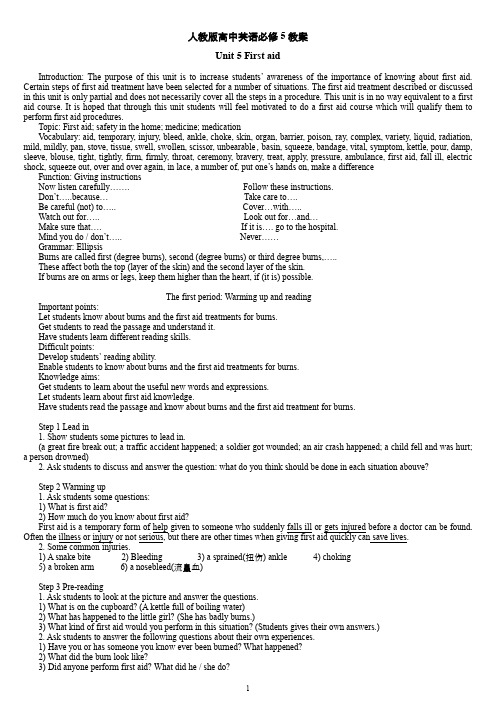
人教版高中英语必修5教案Unit 5 First aidIntroduction: The purpose of this unit is to increase students’awareness of the importance of knowing about first aid. Certain steps of first aid treatment have been selected for a number of situations. The first aid treatment described or discussed in this unit is only partial and does not necessarily cover all the steps in a procedure. This unit is in no way equivalent to a first aid course. It is hoped that through this unit students will feel motivated to do a first aid course which will qualify them to perform first aid procedures.Topic: First aid; safety in the home; medicine; medicationVocabulary: aid, temporary, injury, bleed, ankle, choke, skin, organ, barrier, poison, ray, complex, variety, liquid, radiation, mild, mildly, pan, stove, tissue, swell, swollen, scissor, unbearable,basin, squeeze, bandage, vital, symptom, kettle, pour, damp, sleeve, blouse, tight, tightly, firm, firmly, throat, ceremony, bravery, treat, apply, pressure, ambulance, first aid, fall ill, electric shock, squeeze out, over and over again, in lace, a number of, put one’s hands on, make a differenceFunction: Giving instructionsNow listen carefully……. Follow these instructions.Don’t…..because…Take care to….Be careful (not) to….. Cover…with…..Watch out for….. Look out for…and…Make sure that…. If it is…. go to the hospital.Mind you do / don’t….. Never……Grammar: EllipsisBurns are called first (degree burns), second (degree burns) or third degree burns,…..These affect both the top (layer of the skin) and the second layer of the skin.If burns are on arms or legs, keep them higher than the heart, if (it is) possible.The first period: Warming up and readingImportant points:Let students know about burns and the first aid treatments for burns.Get students to read the passage and understand it.Have students learn different reading skills.Difficult points:Develop students` reading ability.Enable students to know about burns and the first aid treatments for burns.Knowledge aims:Get students to learn about the useful new words and expressions.Let students learn about first aid knowledge.Have students read the passage and know about burns and the first aid treatment for burns.Step 1 Lead in1. Show students some pictures to lead in.(a great fire break out; a traffic accident happened; a soldier got wounded; an air crash happened; a child fell and was hurt;a person drowned)2. Ask students to discuss and answer the question: what do you think should be done in each situation abouve?Step 2 Warming up1. Ask students some questions:1) What is first aid?2) How much do you know about first aid?First aid is a temporary form of help given to someone who suddenly falls ill or gets injured before a doctor can be found. Often the illness or injury or not serious, but there are other times when giving first aid quickly can save lives.2. Some common injuries.1) A snake bite 2) Bleeding 3) a sprained(扭伤) ankle 4) choking5) a broken arm 6) a nosebleed(流鼻血)Step 3 Pre-reading1. Ask students to look at the picture and answer the questions.1) What is on the cupboard? (A kettle full of boiling water)2) What has happened to the little girl? (She has badly burns.)3) What kind of first aid would you perform in this situation? (Students gives their own answers.)2. Ask students to answer the following questions about their own experiences.1) Have you or has someone you know ever been burned? What happened?2) What did the burn look like?3) Did anyone perform first aid? What did he / she do?Step 4 ReadingThe reading passage is a text from a book called “First Aid for the family”. It is a quick-reference book which is organized under headings in such a way that readers can quickly find the information they want. (In this type of text, it is common for information to be in note form. It is also common that ellipsis is used in giving instructions.)1. Fast reading: If you survey a text, it makes it easier to understand it because you already know something about the content and the organization.1) Ask students to read the title of the text and the heading to answer some questions.What is the topic of the text and how is the information organized?(It is about first aid for burns and the information is organized according to causes, types, characters and first aid treatment for burns.)How is the information organized within the heading of Types of burns and Characteristics of burns?(The information is organized according to types of burns: first degree, second degree and third degree burns.)2) Ask students to read the text quickly: What is the information numbered?(The numbers indicate the steps you should take to treat a burn, in the order that they should happen.)3) Show students the following for them to number.____3__ the three types of burns___5___ what to do if someone gets burned___1___ the functions of skin___4___ the symptoms of burns___2____ how we can get burned2. Read the text to do exercises 3 and 4.1) Why should you put cold water on a burn?(Because the cold water stops the burning process, stop the pain and reduces the swelling.)2) Why doesn`t a third degree burn hurt?(Because in a third degree burn the nerves have been damaged. If there are no nerves, there is no pain.)3) Why do you think clothes and jewelry near burns should be removed?(Because the bacteria from the clothes and jewelry could infect the burns.)4) If someone has a third degree burn, why might you see tissue?(Because all the layers of the skin have been burnt showing the tissue underneath.)3. True or false exercises. ( ×√×√)Step 5 Post-reading1. Ask students to have a group discussion on either of the following two questions:1) Why do we say it is important to learn some knowledge of first aid?2) What will you do in an emergency?2. Choose one of each group to report their group discussion to the class.Step 6 Consolidation1. Allow students three minutes to be prepared to retell the passage.2. Invite some students to retell the passage in front of class.Step 7 Homework1. learn the useful new words and expressions in this unit.2. Read the reading passage again and know more about first aid for burns.The second period: Learning about language: Important language pointsThe emphasis of this period will be placed on the important new words, expressions and sentence patterns in the parts Warming up, Pre-reading, Reading and comprehending. Students should first understand their meaning in the context, then give some explanations about them, and later offer some practice to make students master their usage.Important points:1 Enable students to grasp the usage of such important new words and expressions as aid, injury, poison, variety, swell, squeeze, pour, in place.2 Get students to master the following patterns:It is where you feel cold, heat and pain.It is best to place burns under gently running water for about 10 minute.If burns are on arms or legs, keep them higher than the heart, if possible.Difficult points:Let students learn the usage of the word present and expression in place.Get students to learn and understand some difficult long sentences.Knowledge aims:Some new words and expressions: aid, temporary, injury, bleed, ankle, choke, cupboard, skin, organ, barrier, poison, ray,complex, variety, liquid, radiate on, mild, mildly, pan, stove, tissue, swell, swollen, scissors, unbearable, basin, squeeze, bandage, symptom, kettle, pour, wrist, damp, sleeve, blouse, tight, tightly, first aid, electric shock, squeeze out, over and over, in placeSome sentence patterns:…..It prevents your body from losing (too much) water…..…..it is where you feel cold, heat and pain……It is best to place burns under gently running water for about 10 minutes.For second degree burns, keep clothes cool by putting them back in a basin of cold water…..If burns are on arms or legs, keep them higher than the heart, if possible.Step 1 RevisionCheck the homework exercises.Ask some students to talk about first aid for burns.Step 2 Reading and findingRead the text through to find out the important phrases: first aid, fall ill, get injured, give first aid, save lives, perform first aid, act as, prevent ….from, sense of touch, get burnt, a variety of, be close to, depend on, for a moment, electric shock, at once, black and white, take off, be stuck to, running water, squeeze….out, over and over again, get infected, cover….with, stick …to, in place, if possible, sit up, get sb. knock over, full of, boiling water, keep doing, catch fire, pick off, bits of Step 3 Discovering useful words and expressions1) When do you need to use your knowledge about first aid? When somebody suddenly falls ill or has no accident?2) What is the skin? It is an organ which acts as a barrier against disease, poisons and the sun`s harmful rays.3) Why are the functions of skin described as complex? It keeps you warm or cool; it prevents your body from losing too much water and provides you with your sense of touch.4) What can hurt the layers of the skin? Hot liquids from pans on the stove, electric shocks, radiation, fire and the sun.5) What is it vital to do if you had third degree burns? Go to the hospital.6) What are the symptoms of first degree burns? They are dry, red and mildly swollen.Step 4 Studying important language points1 first aid: treatment given to an injured person before a doctor comesFirst aid to the injuredFirst for burnsGive / offer to sb`s aidCut off aidA hearing aid injury创伤或伤害,尤其指意外受伤medical aid harm精神或肉体上的损害,with the aid of…. hurt情感上的伤害,肉体的伤痛2 fall ill wound战争或打斗中受伤,尤指刀伤,枪伤He fell ill and had to be sent to hospital. damage指损失,损害,不表示伤痛,主要是指物fall asleepFall silent3 get injured: (get + 过去分词)My bike is getting repaired now.Peter and Merry got married last year.4 injury: a physical hurt or wound, especially when caused accidentlyThe driver of the car received serious injuries to the legs and arms.What you said was an injury to her fame.5 injure: to harmThere were two people injured in the car accident.To injure a man`s prideFill in the blanks with injury, harm, hurt, wound or damageHe got serious injuries to the leg at work.The soldier received two wounds in the battle.The storm did great damage to the crops.The harm / hurt to her feeling is more than that in the body.6 act as: perform the role or function ofI don`t understand their language; you will have to act as the interpreter.7 sense of touch / sight / hearing / taste / smell /Sense of direction / urgency / guilt / honor / justice / hunger / responsibility / valuesThe moral senseThe sixth sense8 depend on9 unless10 stick: 粘住to become fixed; joined or fastened with a sticky substanceThis glue doesn`t stick very well.Please stick a stamp on an envelope.The dough stuck to my fingers.That is my story and I am sticking to it.You will succeed if you stick to it(坚持).11 It is best to do…….最好的是…….12 squeeze: to press on from opposite sides or all sides 挤压,捏,榨汁Don`t squeeze the kitten(小猫); you will hurt it.The children squeezed together to make room for me to sit down.Squeeze the juice out of a lemon13 over and over again: many times; repeatedly14 in place: in the usual or proper position; suitable or appropriateA little gratitude would be in place. 应当略表谢意。
必修五 Unit 5 First aid
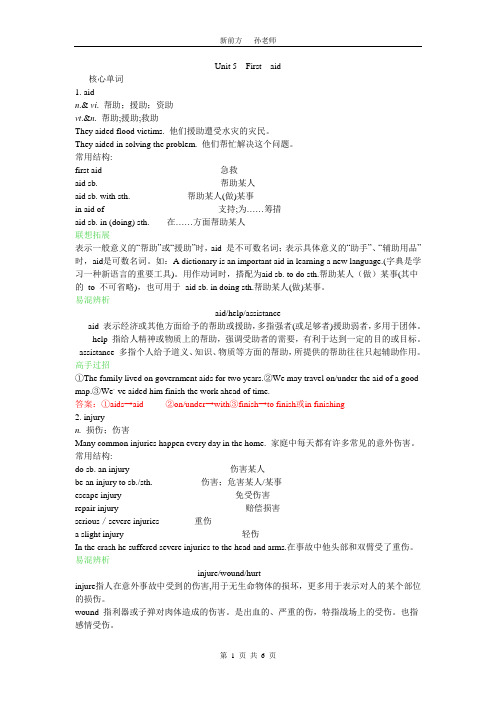
Unit 5 First aid核心单词1. aidn.& vi. 帮助;援助;资助vt.&n. 帮助;援助;救助They aided flood victims. 他们援助遭受水灾的灾民。
They aided in solving the problem. 他们帮忙解决这个问题。
常用结构:first aid 急救aid sb. 帮助某人aid sb. with sth. 帮助某人(做)某事in aid of 支持;为……筹措aid sb. in (doing) sth. 在……方面帮助某人联想拓展表示一般意义的“帮助”或“援助”时,aid 是不可数名词;表示具体意义的“助手”、“辅助用品”时,aid是可数名词。
如:A dictionary is an important aid in learning a new language.(字典是学习一种新语言的重要工具)。
用作动词时,搭配为aid sb. to do sth.帮助某人(做)某事(其中的to 不可省略),也可用于aid sb. in doing sth.帮助某人(做)某事。
易混辨析aid/help/assistanceaid 表示经济或其他方面给予的帮助或援助,多指强者(或足够者)援助弱者,多用于团体。
help 指给人精神或物质上的帮助,强调受助者的需要,有利于达到一定的目的或目标。
assistance 多指个人给予道义、知识、物质等方面的帮助,所提供的帮助往往只起辅助作用。
高手过招①The family lived on government aids for two years.②We may travel on/under the aid of a good map.③We,ve aided him finish the work ahead of time.答案:①aids→aid ②on/under→with③finish→to finish或in finishing2. injuryn.损伤;伤害Many common injuries happen every day in the home. 家庭中每天都有许多常见的意外伤害。
最新新人教版必修5_Unit5《First_Aid》教案
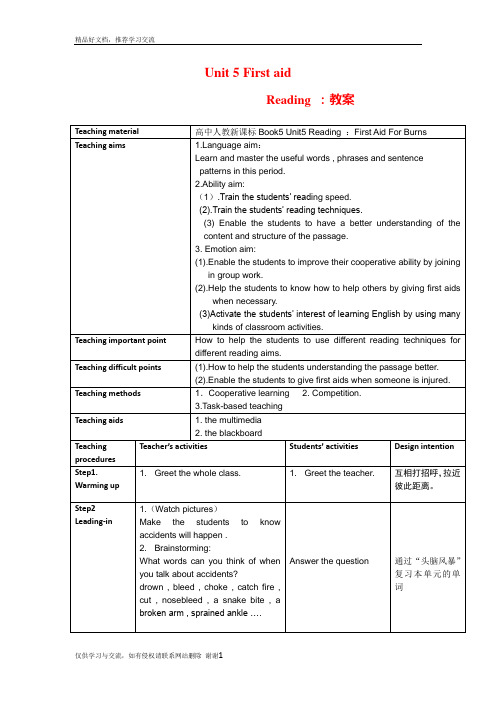
Unit 5 First aidReading :教案3.(Watch pictures)Nowadays there are a lot of unexpected accidents. What would you do in such situations?What is first aid? Look at the pictures.Work in groups to givethe answers:First aid is a temporaryform of help given tosomeone who suddenly___falls ill or _getinjured___ before adoctor can be found.通过图片让学生形象、直观地感受first aid,并对firstaid定义,从而自然导入新课。
采用小组合作、抢答形式,激发学生的合作意识。
Step3pre-reading 1.Present a picture and ask:(1). What has happened to the littlegirl?(2).How will her mother deal with theburn?Look the picturecarefully and discuss ingroups. Choose onemember to give theanswers:(1).Boiling water haspoured into the little girl.利用教材中的图片及设问方式导入本课的主题First Aid ForBurns。
Step4While-readingReading for general idea.1. Make the students to skim thepassage in limited time and geta general idea of the passage,then number these topics.__3__ the three types of burns__5__ what to do if someone getsburned__1__ the functions of skin__4__ the symptoms of burns__2__ how we get burnsReading for details1.Ask the students to read Part 1-2question:1). What can skin do for our body?2). How can we get burnt?Students workindividually to give theanswers according tothe passage.Students read Part1-2and find out the answer:● protect you againstdiseases, poisons andthe sun’s harmful rays● keep you warm or cool● prevent your bodyfrom losing much water在整个的阅读过程中培养学生通过略读获得文章大意的能力。
人教版必修5 Unit 5 First aid 实用课件 (4)

①不要把我当傻瓜a。s a fool D②o我n’决t定tr请ea你t m们e 喝__啤__酒_t_。o___ s__o_m__e___ .beer
I decide to treat you ______ _______ ________ .
9. Examples include burns caused by electric shocks, burning clothes or severe petrol fires.
—Press a clear piece of cloth on the ________ first. I’ll call the doctor. A.hurt B.injury C.wound D.harm 解析:C 根据“I’ve cut my finger and I’m bleeding.”可知是“刀伤”,应用wound。第二句意 思是“先在伤口上按一块干净的布,我给医生打电 话”。
treat cure heal
“治疗”,着重强调过程,不涉及结 果,不一定治愈。
治愈,治好;矫正,纠正。多指病后 恢复健康或消除不良行为,其后可接 表疾病和人的名词或代词,强调治疗 的结果。
(伤口或断骨)愈合复原,多用于治 疗外伤,也可指矛盾或分歧。
Exercise:
1. The doctors __tr_e_a_t_e_d__ him with the newly developed medicine, but they didn’t _c_u_r_e____ him of his cancer.
②Varieties of reasons were offered for the failure. 这次失败原因很多。
---- vary vt./ vi. 使不同;变更;变化;呈多样化 vary with… 随......变化
人教新课标高中英语必修五Unit 5 First aidUnit 5 First aid教案(3)

Unit 5 First Aid 教案2(HEROIC TEENAGER RECEIVES AWARD<PART 2>) IntroductionYou are advised to lead in by talking about a teenager. Then help students with their reading of HEROIC TEENAGER RECEIVES AW ARD. Translation of the text into Chinese is proposed. Objectives■To help students make use of what they learned in this unit in communication■To help students use the language by reading, listening, speaking and writing Procedures1.Warming up by talking about John Janson.Do you know John Janson? Do you know the Lifesaver Award?2. ReadingStep 1 Skimming the newspaper article1.Read the headline:What is the story about?2. Read the first paragraph and fill in the chart.Who John JansonWhen Last nightWhere RivertownWhy carrying out first aid on a neighborwhat honored at the Lifesaver Awards3. Put these events in the order that they happened._4_ The attacker ran away._1_ Anne was attacked and started to scream._6_ John performed first aid on Anne_2_ John was studying in his house._7_ The ambulance arrived._3_ John ran outside with his father._5_ John found Anne in her garden with terrible knife wounds.4. Answer the questions1) What was John honored for?2) What did John do when he heard the screaming?3) What happened to Anne?4) What saved Ms. slade’s life?5) What first aid did John perform on Anne?6) What adjectives would you use to describe John’s actions?Step 2 Discussion1. Do you think John was silly or brave to get involved in the situation? Give reasons.2. Would you have done the same as John? Give reasons3. Do you think it is worthwhile to take a course in first aid? Give reasons.Step Three Language study1.John was presented with hisT: Please open your books to Page 39.The first aid teacher is testi ng her students’ knowledge of first aid. What topics does the teacher ask questions about? Circle the correct ones from the box.T: Now let’s come to the second part of this exercise. You can see four pictures there. Look at these pictures, and match each picture with a topic listed in question 1 above.Ask one or two students to giveT: Next I’d like you to work in pairs, and use the pictures above to help you to give your partner first aid instructions for each situation. Then I’ll ask you to perform your preparati ons to the class.Give the students two to three minutes for them to prepare, and then ask several groups to theT: In the box of Exercise 1, there is an item called bruising, do you know what is?T: From the Internet we can find some articles about bruising.for the information about this iIf the Internet is not available, the teacher can show the following passage to the students.Step 5 WritingT: Next I would like you discuss whether you think it is worthwhile to take a course in first aid.S: ...T: Just now many of you think it is worthwhile to take a course in first aid. But there is no such course in our school. Do you want to persuade our headmaster to add this course to our curriculum?S: Yes.T: I’m very pleased to hear that. Now I hope you to write a letter to give your suggestions to our headmaster about this.Example:Dear Headmaster:I am a student from Class 1, Grade 2.This week in our English class, we are learning a unit about first aid. In the course of learning this unit, we get to know that every year there are many people who get hurt or even killed because of some unexpected accidents. After discussion and searching the Internet, we think if we can learn some general knowledge at school, we can get some basic skills to save people’s life as well as that of ourselves in the future. So we think that it is importantIt’s a pity that we have no such course in our school. But we think that course on first aid not only can bring us knowledge but also can encourage our willingness to help others, and this is theGiven these reasons we think that the course of first aid is good to our students as well as to the whole society.Students of Class 1, Grade 2 Step 6 Homework1. Search the Internet for some information about the safety in gymnastic training and then write a2. Complete。
英语全能人教版讲义必修5Unit5Firstaid
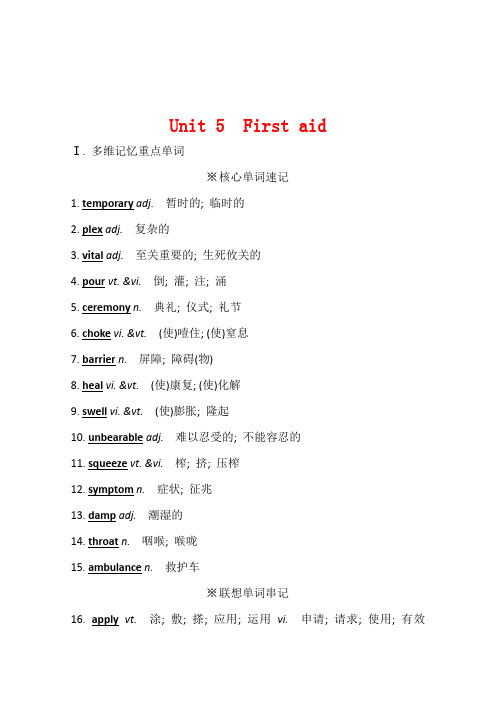
Unit 5 First aidⅠ. 多维记忆重点单词※核心单词速记1. temporary adj. 暂时的; 临时的2. plex adj. 复杂的3. vital adj. 至关重要的; 生死攸关的4. pour vt. &vi. 倒; 灌; 注; 涌5. ceremony n. 典礼; 仪式; 礼节6. choke vi. &vt. (使)噎住; (使)窒息7. barrier n. 屏障; 障碍(物)8. heal vi. &vt. (使)康复; (使)化解9. swell vi. &vt. (使)膨胀; 隆起10. unbearable adj. 难以忍受的; 不能容忍的11. squeeze vt. &vi. 榨; 挤; 压榨12. symptom n. 症状; 征兆13. damp adj. 潮湿的14. throat n. 咽喉; 喉咙15. ambulance n. 救护车※联想单词串记16. apply vt. 涂; 敷; 搽; 应用; 运用vi. 申请; 请求; 使用; 有效→application n. 申请; 应用17. injury n. 损伤; 伤害→injure vt. 损伤; 伤害; 使受伤→injured adj. 受伤的; 有伤的18. poison n. 毒药; 毒害vt. 毒害; 使中毒→poisonous adj. 有毒的19. variety n. 变化; 多样(化); 多变(性)→various adj. 各种各样的→vary v. 改变; 使多样化20. mild adj. 轻微的; 温和的; 温柔的→mildly adv. 轻微地; 温和地21. tight adj. 牢的; 紧的; 紧密的→tightly adv. 紧地; 牢牢地22. firm adj. (动作)稳定有力的; 坚定的→firmly adv. 坚固地; 稳定地23. bravery n. 勇敢; 勇气→brave adj. 勇敢的; 有勇气的→bravely adv. 勇敢地24. treat vt. &vi. 治疗; 对待; 款待n. 款待; 招待→treatment n. 治疗; 疗法; 对待; 待遇单句语法填空1. There are hundreds of poisonous spiders and snakes. (poison)2. Keep your eyes firmly fixed on the road ahead. (firm)3. Her eyes were red and swollen from crying. (swell)4. She almost choked to death in the thick fumes. (choke)5. He held on tightly to her arm. (tight)6. The people in the floodstricken area fought bravely against the natural disaster. Their bravery deserved praising. (brave)7. We like to live a life full of variety and men’s tastes are various. (vary)8. People had to treat themselves in their own way before they received the treatment sent by the government. (treat)9. Tom got badly injured in the car accident. The injury to his leg was really serious. (injury)Ⅱ. 语境记忆重点短语1. fall ill生病2. first aid(对伤患者的)急救3. make a difference区别对待; 有影响; 起(重要)作用4. squeeze out榨出; 挤出5. over and over again反复; 多次6. in place在适当的位置; 适当7. prevent. . . from. . . 阻止……8. put one’s hands on找到9. take off起飞; 匆匆离去; 突然大受欢迎10. act as担任11. get burned烧伤12. a number of若干, 许多用以上短语的适当形式填空1. Arriving in London, she suddenly fell ill because she couldn’t bear the changeable weather.2. The professor always urges us that everything should be put in place before we leave the lab.3. I’m sure that our hard work can make a difference and everything will be OK.4. I’ve told you over and over again not to do that but you won’t listen.5. My writing career took off when I discovered my own style.6. Hannah was busy with work then but she still tried her best to squeeze out some time from her tight schedule to visit her mother.Ⅲ. 应用记忆经典句式1. So as you can imagine(正如你们可以想象的), if your skin gets burned it can be very serious. (as引导非限制性定语从句)2. Remove clothing using scissors if necessary unless it is stuck to the burn(除非衣服紧贴在烧伤面上). (unless引导条件状语从句)3. John was studying (正在学习) in his room when (这时突然) he heard screaming. (when用作并列连词)4. It was John’s quick action (正是约翰的迅速行动) and knowledge of first aid that saved Ms Slade’s life (救了斯莱德女士的命). (强调句型)5. There is no doubt that (毫无疑问)John’s quick thinking and the first aid skills he learned at school saved Ms Slade’s life. (There is no doubt that+同位语从句)句式仿写1. 除非他妈妈给他讲故事, 否则那个小男孩不睡觉。
- 1、下载文档前请自行甄别文档内容的完整性,平台不提供额外的编辑、内容补充、找答案等附加服务。
- 2、"仅部分预览"的文档,不可在线预览部分如存在完整性等问题,可反馈申请退款(可完整预览的文档不适用该条件!)。
- 3、如文档侵犯您的权益,请联系客服反馈,我们会尽快为您处理(人工客服工作时间:9:00-18:30)。
Dictation 必修五Unit 5 First aid 姓名FIRST AID FOR BURNSThe skin is an 1 part of your body and its largest organ. You have three 2 of skin which act as a barrier against disease, poisons and the sun's harmful rays. The functions of your skin are also very 3 : it keeps you warm or cool; it prevents your body from losing too much water; it is 4 you feel cold, heat or pain and it gives you your sense of touch. So as you can imagine, if your skin gets burned it can be very serious. First aid is a very important first step in the treatment of bums.Causes of burnsYou can get burned by a 5 of things: hot liquids, steam, fire, radiation (by being close to high heat or fire, etc), the sun, electricity or chemicals.Types of burnsThere are three types of burns. Burns are called first, second or third degree burns, depending on which layers of the skin are burned.◎First degree burns These affect only the top layer of the skin. These burns are not serious and should feel better within a day or two. Examples include 6 sunburn and burns caused by touching a hot pan, stove or iron for a moment..◎Second degree burns These affect both the top and the second layer of the skin. These bums are serious and take a few weeks to 7 . Examples include 8 sunburn and bums caused by hot liquids.◎Third degree burns These affect all three layers of the skin and any 9 and organs under the skin. Examples include burns caused by electric shocks, burning clothes, or severe petrol fires. These burns cause very severe injuries and the 10 must go to hospital at once.11 of burnsFirst degree burns◎dry, red and mildly 12◎mildly painful◎turn white when pressedSecond degree burns◎rough, red and swollen◎blisters◎13 surface◎14 painfulThird degree burns◎black and white and 15◎swollen; often tissue under them can be seen◎little or no pain if nerves are damaged; may be painaround edge of injured area.First aid treatment1 Remove clothing using 16 if necessary unless it is stuck to the burn. Take off other clothing and jewellery near the burn.2 Cool burns immediately with cool but not icy water. It is best to place burns under gently running water for about 10 minutes. (The cool water stops the burning process, prevents the painbecoming 17 and reduces swelling.) Do not put cold water on third degree burns.3 For first degree burns, place cool, clean, wet cloths on them until the pain is not so bad. For second degree burns, keep cloths cool by putting them back in a 18 of cold water, squeezing them out and placing them on the burned area over and over again for about an hour until the pain is not so bad.4 Dry the burned area gently. Do not rub, as this may break any blisters and the wound may get 19 .5 Cover the burned area with a dry, clean 20 that will not stick to the skin. Hold the bandage in place with tape. Never put butter, oil or ointment on burns as they keep the heat in the wounds and may cause infection.6 If burns are on arms or legs, keep them higher than the heart, if possible. If bums are on the face, the victim should sit up.7 If the injuries are second or third degree burns, it is vital to get the victim to the doctor or hospital at once.21 n. & vt. 帮助;援助;资助22 (对伤患者的)急救23 adj. 暂时的;临时的24 生病25 n. 损伤;伤害26 vi. & vt. ( , )流血27 n. 鼻出血;流鼻血28 vt. 扭伤29 adj. 扭伤的30 n. 踝(关节)31 vi. & vt. (使)噎住;(使)窒息32 n. 橱柜;衣柜33 n. 皮;皮肤34 adj. 最重要的;不可缺少的;本质的35 n. 器官36 n. 层;层次37 n. 屏障;障碍(物)38 n. 毒药;毒害vt. 毒害;使中毒39 n. 光线;射线40 adj. 复杂的41 n. 变化;多样(化);多变(性)42 n. 液体43 n. 辐射;射线44 adj. 轻微的;温和的;温柔的45 adv. 轻微地;温和地46 n. 平底锅;盘子47 n. 炉子;火炉48 vi. & vt. (使)康复;(使)化解49 n. (生物)组织;薄的织物;手巾纸50 电;电休克51 vi. & vt. ( )(使)膨胀;隆起51 adj. 肿胀的52 n. 水泡vi. & vt. (使)起泡53 adj. (似)水的54 vi. 烧焦55 n. 神经;胆量56 n. (pl.) 剪刀57 adj. 难以忍受的;不能容忍的58 n. 盆;盆地59 vt. & vi. 榨;挤;压榨60 榨出;挤出61 反复;多次62 n. 绷带63 n. 药膏;油膏64 在适当的位置;适当65 n. 传染;传染病;感染66 adj. 至关重要的;生死攸关的67 n. 症状;征兆68 vt. 加标签或标记;分类n. 标签;标记69 n. (水)壶;罐70 vt. & vi. 倒;灌;注;涌71 n. 手腕72 adj. 潮湿的73 n. 袖子74 n. 女衬衫75 adj. 牢的;紧的;紧密的76 adv. 紧地;牢牢地77 adj. (动作)稳定有力的;坚定的78 adv. 坚固地;稳定地79 n. 咽喉;喉咙80 n. 典礼;仪式;礼节81 n. 勇敢;勇气82 vt. & vi. 刺;戳;刺伤83 若干;许多84 找到85 vt. & vi. 治疗;对待;款待n. 款待;招待86 vt. 涂;敷;搽;应用;运用vi. 申请;请求;使用;有效87 n. 压力;挤压;压迫(感)88 n. 救护车89 n. 方案;计划90 区别对待;有影响;起(重要)作用91 n. & vi. 瘀伤;擦伤。
